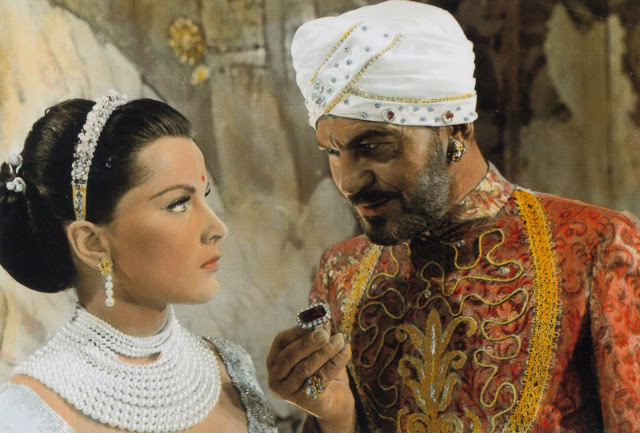Jim and Sam Present Paget and Pagans!
1960 was finally time for American-International to live up to its name. No more would Jim Nicholson and Sam Arkoff rely on a domestic market for the bulk of receipts. Henceforth they'd branch past US shores to sell and buy. Foreign rentals accounted for 30% of AIP's 1959 take, with 1960 projecting at 50%, this the 9/30 forecast Jim shared with Variety's Vincent Canby. A hands across seas policy had given Nicholson/Arkoff their biggest so-far hit, Goliath and The Barbarians, to be followed with economy models Euro-shot, but adorned with production values hard got in the US short of spending a million AIP didn't have. Jim and Sam wanted desperately into A's, and so charted 1960's mission of making imports and upgraded domestic product look expensive at least. Here then, was crossroads where an industry's hungriest upstart made a meal of Fritz Lang's farewell to epic filmmaking.
 |
| Jim Nicholson and Sam Arkoff Display Wares of a Boffo 1960 Season To Come |
Herr Lang still had a reputation, if not many takers for directing service.
The pair translated to The Tiger Of Eschnapur and The Indian Tomb. Despite deadly reviews (some of the most unfortunate German postwar productions, one said), they did well on the continent, thanks in part to Brauner's casting a known Hollywood lure, Debra Paget, as star and promoting ornament. Germany's most expensive baubles Euro-played from January 1959 (nothing Deutsch-made had cost so much, not even Lang's silent extravagances) and would not escape notice by pleasure/business traveling Jim and Sam, always on the lookout for exploitable product AIP could retrofit for home consumption.
Arkoff wrote colorfully of he and Nicholson's screening agenda when in
Jim Nicholson spent much of August 1960 checking progress of AIP co-productions shooting overseas. There was Konga in
 |
| The Debra Paget Dance That Adorned US Lobby Cards for Journey To The Lost City ... |
 |
| ... and the Dance Euro Patrons Saw. |
Jim Nicholson cut Journey To The Lost City to 94 minutes, Lang's length split pretty much down the middle. That didn't leave much time for dull explanations of various plot details, said Variety. Reviews hinted Journey might still be too long. The "sex-and-sand spectacle" had nice scenics, but dialogue was "ali-babble all the way." Still, there were kids enough to finesse $494,000 in domestic rentals, a nice take in an AIP year that saw House Of Usher and Goliath grossing highest for the firm. Fritz Lang didn't go on record as to Nicholson's cleave-by-half of his Indian epic, but the two did meet for discussion of AIP remaking Metropolis, rights to which Jim and Sam acquired shortly after the Tiger/Tomb buy. According to Variety, Nicholson prevailed upon Lang to direct AIP's update, but the director has declined, understandably says Nicholson, on the grounds that the new version would certainly be compared with the old, and probably in an unflattering way, no matter how good he could make it.











